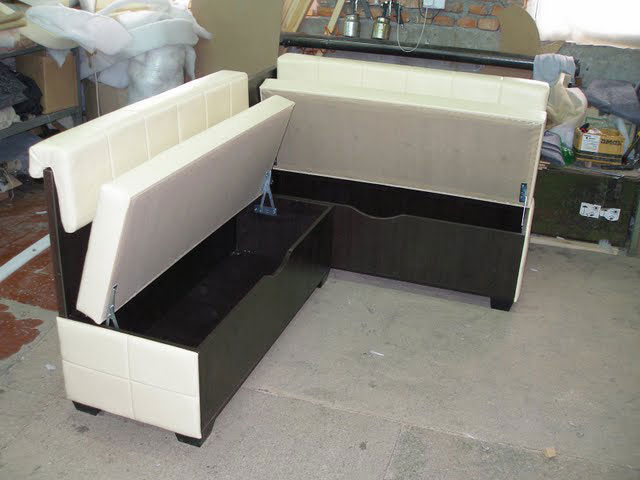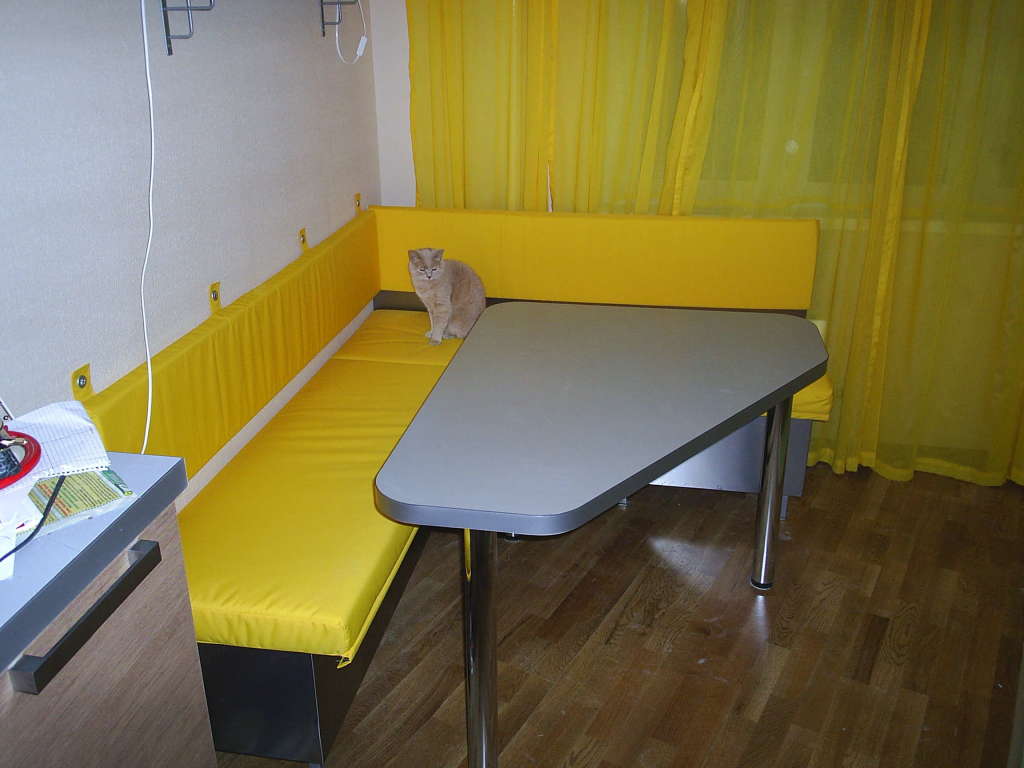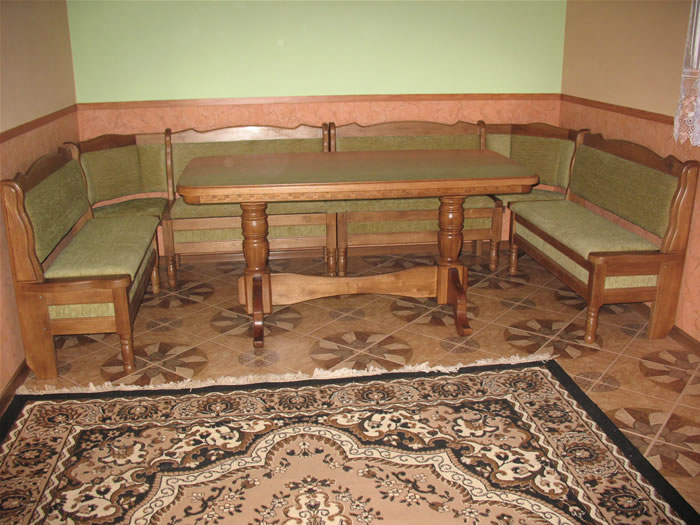Do-it-yourself kitchen corner - where to start and what to look for
The organization of a kitchen is not only about acquiring modern household appliances and kitchen furniture that provide a comfortable, ergonomic space. The necessary comfort is achieved by arranging a place where the whole family could gather to take a meal and have a leisurely conversation. For this, another expensive purchase is completely unnecessary. Making and assembling a kitchen corner with your own hands is quite within the power of any home craftsman.
Types and features of kitchen corners
The sets of such furniture offered for manufacture usually have a standard set: a corner sofa with a back, a table and a couple of stools or ottomans. Here it is important to pay attention to the future dimensions of the kitchen corner, which should be commensurate with the overall dimensions of the room and fit into the layout in order to minimize the use of the available free space and not interfere with moving around the kitchen. Kitchen corners can be of several types:- standard;
- bay windows;
- modular;
- sliding.
Standard models visually look like a single one-piece structure, consisting of two seats, fastened with one more corner. As the latter, an element in the form of a small pedestal can be used. This arrangement allows you to make the most of the corner spaces.
Bay window models are more often used to equip the dining area in the recesses of the premises. The shape of the bay window - semicircular, triangular or square, itself will help determine the configuration of the kitchen corner in order to perfectly fit it into the niche.
DIY kitchen corners allow you to increase their functionality.

Modular solutions provide the ability to modify the configuration of the entire structure by rearranging individual elements. Their quick assembly and disassembly allows individual use of individual modules without connecting them. Sliding systems are equipped with more expensive models of kitchen corners, allowing, for example, to transform a table to increase its area or sofas, providing them with a berth. If you provide hidden niches in the sofas for storing various household utensils, then such a storage will replace an additional kitchen cabinet and help save space.
Where to begin
You can immediately make a reservation that with the right approach it will not be necessary to plan, saw or paint something. It is much easier to make a kitchen corner with your own hands if you use the services of "Tables for cutting wood-shaving materials", which can be found in almost any locality. Ordering a cut according to your own drawings frees you from rough work and the acquisition of additional expensive tools - a circular electric saw, a grinder, a router, etc. In addition, a high-quality edge on the front surfaces when cutting and facing, especially on curly parts, can only be made using professional equipment.

If all this is taken into account, then in the future you only need to stock up on the necessary amount of fastening accessories - metal furniture corners, dowels, confirmations, self-tapping screws, as well as purchase foam rubber and upholstery fabric for the seats. Before you make a kitchen corner with your own hands, you need to pay attention to some points. This will require:
- choose the right configuration, since sofas can be left-sided or right-sided, depending on the angle in which they can be located;
- determine the dimensions of the constituent elements of the kitchen corner in length and width in such a way that they come as close as possible to the wall and to each other, minimally using, at the same time, such a scarce kitchen area;
- choose the most optimal seat height from the floor for all family members for the kitchen corner. To do this, it is enough to measure the height of the most comfortable chair in the house;
- try to draw up drawings of each part correctly and prepare a specification for detailing the necessary consumables and fasteners.
Making a standard kitchen corner with your own hands, the drawings of which can be found on the Internet, is not difficult. But in any case, the dimensions will be selected individually and recalculated in accordance with the requirements. If we focus on the indicators of ergonomics, then their values can be approximately as follows:
- the height from the floor to the seat is on average 45 cm;
- seat depth - no more than 50cm;
- length of sofas - 120-200cm;
- total height with backrest - 85-95cm.
Before assembling a kitchen corner, you need to prepare enough free space for work and stock up on a simple tool - a drill, screwdriver or screwdrivers, a hammer or a stapler.
This set will be enough.
What to look for when assembling
At the base of the sofa (along its entire length) there is a box, which is a rigid structure of a bar, sheathed with laminated chipboard of medium density with a thickness.
The supporting elements are two figured sidewalls, to which the assembled box is attached using dowels and self-tapping screws.
The upper cover serving as a seat is placed on the piano hinge and, if desired, can be retrofitted with a lifting mechanism.

The front side of the box is tilted 10-15 degrees downward and inward for ease of sitting.
The backrest is made of polished chipboard with fixing the plates between the sidewalls on dowels and reinforcing it with metal corners.
To strengthen the back of the sofa, the sidewalls in the middle of the upper part are connected by a persistent bar made of a bar or polished chipboard.
How to fill and upholster kitchen corner seats
Hard wooden seats of sofas and stools are not entirely comfortable for a comfortable pastime at the dining table, so before how to make a kitchen corner, care should be taken to obtain a suitable filling and upholstery fabric. Lining made of polyurethane foam (PPU), otherwise - foam rubber specially designed for these purposes, allows making the seats soft and elastic. The most suitable are the grades of sheet foam rubber ST1825 and ST1836 of the standard softness group. It is best to use them in a mutual combination, since the use of only one soft polyurethane foam of the ST1825 brand will lead to deformation of the seat and a rapid loss of its shape and elasticity.
Cut-to-size foam parts are glued to the seat and back with any synthetic glue. This prevents the material from sliding off when wrapped with decorative material and does not allow the filler to stray during operation.
Cutting thick foam rubber is best done with a red-hot nichrome thread. Thin filler is quite possible to cut with an ordinary knife.

The selection of the appropriate upholstery of furniture elements will help to organically fit the kitchen corner into the interior of the room. When choosing materials, it is worth remembering that all items in the kitchen are much more likely than usual to be exposed to dirt and high humidity, therefore special requirements are imposed on such materials. Among the wide assortment, the most used can be distinguished.
- Artificial leather. Modern technologies make it possible to obtain materials with improved consumer properties - they are pleasant to the touch, hygroscopic, wear-resistant and do not emit harmful substances. Leather upholstery does not visually differ from genuine leather, as it imitates its texture and can have a different color scheme.
- Arpatek. The unparalleled durable upholstery fabric, which was developed specifically for upholstery car seats, resembles finely finished soft leather. The fabric retains its original color for a long time, as it is not afraid of ultraviolet radiation and is perfectly cleaned without leaving stains from natural juices and wine on its surface.
- Microfiber. It is not for nothing that it is called furniture suede, as it imitates its natural counterpart as much as possible. Practical and durable fabric is dust and moisture repellent, breathable and does not deform when stretched.
- Scotchguard, or thermohackard. Fabric with a special impregnation, which gives the material special properties - resistance to dirt, protection from dirt and dust, oil and water repellency. The applied layer of transparent synthetic tread protects the threads from premature abrasion and increases the mechanical strength of the fabric.
If you plan to restore the kitchen corner with your own hands with a constriction of worn seat material, then do not forget, also, about traditional upholstery fabrics - cotton, corduroy, jacquard - which are not so practical, but quite suitable for upholstery. No special preparation of the material, for example, sewing or overcasting, is required. It is enough to cut it to size, wrap it around the part, picking up the hanging corners, and fix it with a stapler, fixing the staples in steps of a few centimeters.

How to add and equip a kitchen corner
The most rational is the standard set of kitchen nooks with two stools and a small dining table. When making them, it should be borne in mind that the materials used must be in harmony and correspond to those previously used. An alternative solution is a modern glass table and transparent metal-framed stools.
